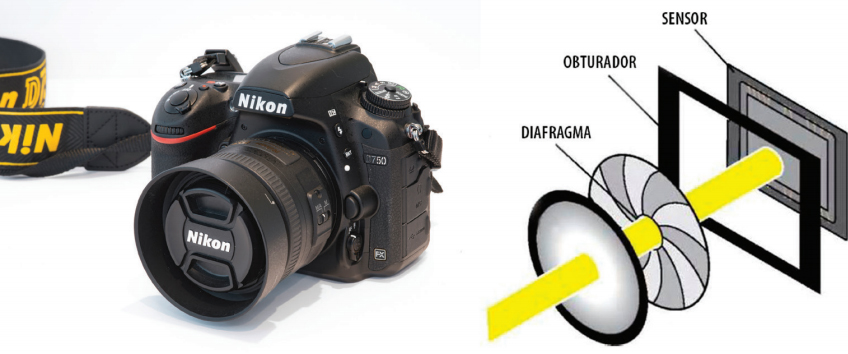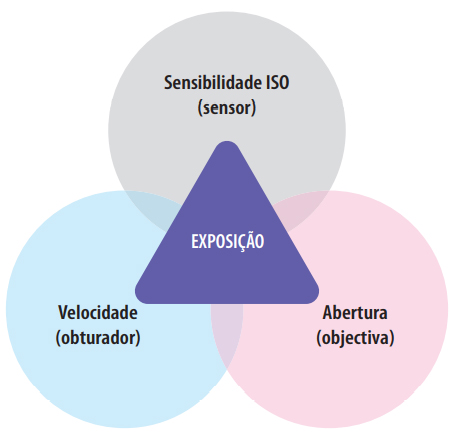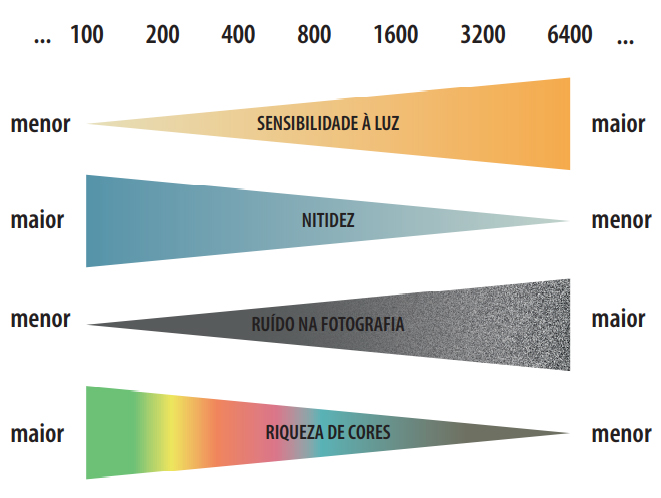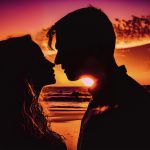ISO exposure triangle
According to previous articles published here on FotoBlog, it is known that the sensor has the role of recording the image and its quality is linked to its size and the number of pixels registered by it, forming the image.
Although it is a key part of a photo's result, it doesn't operate alone. To record the image on this sensor efficiently, it is necessary a set of factors that work together, allowing the light to reach the end of its path in adequate volume and time, for each type of situation.
Components
Photography takes place when the camera's sensor is exposed to light for as long as it takes to form the desired image. In the camera body, there are components that work together to make photography happen, as you can see in the image below.

The primary factors linked to the efficiency of sensor use are ISO sensitivity, shutter speed and aperture. Together they form the exposure triangle.

While the ISO is responsible for the image recording quality on the sensor, the shutter takes care of the light exposure time and the diaphragm, the depth of field and the amount of light that the lens will receive.
ISO: sensor sensitivity, responsible for image quality.
shutter: responsible for the sensor's exposure time to light.
Diaphragm: responsible for the depth of field and volume of light entering the lens.
Thus, the following content will unfold each of these steps so that you can understand and correctly use the exposure triangle, necessary to operate the camera correctly in non-automatic modes.
Pillars of the Exposure Triangle
ISO – International Organization of Standardization.
ISO is a scale for measuring the sensor's sensitivity to light, and the lower the number, the lower the sensor/film sensitivity, thus having a finer grain. The higher the ISO, the greater the sensitivity to light. The use of high ISO is ideal for places with low light, however, by raising the ISO value too much, the grain size also increases, resulting in noise in the image. In the case of digital photography, pixels become larger, with a simple zoom to see the points that build the image.
ISO x ASA
ISO is for digital cameras comparable to (but not a substitute for) a measurement known as ASA for analog cameras using film. While the ISO changes with each photo, the ASA numbering was defined for the entire roll of film, not allowing the change until the entire content was used. Thus, the film was acquired in ASA 100, 200, 400 or 800, according to the light situation and type of scene expected by the photographer. The measure was equivalent to all the “poses” contained in 12, 24, 36 or 48 photo films, and could not be changed. Today, with the advancement of digital technology, settings are modified according to each scene or subject to be recorded.
The myth
There is a myth in digital photography that the ISO positioned at 100, as a value considered low, is ideal for image quality. It is true that smaller values tend to maintain a varied range of colors and make the image less grainy, as you can see in the images. However, lower ISOs require greater amounts of light. Depending on the lighting situation the scenes are exposed to, the ISO value is chosen for larger or smaller numbers.

shutter and diaphragm opening. Smaller numbers mean less noise in the image
ISO graduation

There are three adjustment pillars for a photograph to have good reading conditions: ISO sensitivity, shutter speed and aperture. Therefore, when these three pillars are combined, different results are achieved in photography, increasing or decreasing the visual quality according to each combination and use of the light that passes through the lens.
Noise
Along with aperture and shutter speed, this setting plays a key role in exposing an image. Low ISO is sometimes described as “slow” because using it usually makes a slow shutter speed necessary. High values are often called “fast” because they allow a “fast” speed to be used.
The image sensor is light-receptive and has an electronic current, or signal, that passes through it and feeds the image information to the processor before the data is transferred to the memory card. When you change the ISO, you're not actually increasing the sensor's sensitivity to light, but rather adjusting the strength of the signal passing through it. Increasing the signal has the unwanted side effect of increasing noise which becomes more visible in photos with fast ISOS. The higher the ISO, the stronger the signal and therefore the greater amount of noise present in the images.
Hence the importance of compensating for this typical graininess of high (or fast) ISO values through higher speeds or larger apertures.
Compensation | ISO exposure triangle
A good example is a photo produced in sports competitions, inside museums or shows where the use of flash is not allowed. In situations like these, it is very likely that the ISO set to 100 will not result in a good photo due to the low light condition. In this case, you can compensate for the ISO increase by speeding up the shutter speed.
CONTINUED IN NEXT ARTICLE
Anyway, we will meet in the next article on photographic technique.
So, did you like the article on ISO Exposure Triangle and want to contribute a coffee of thanks? Make your contribution using the QR Code below. Help the Foto Blog that helps you. Any value is welcome! A coffee is R$2 here, for example.

Related articles
| Make long exposure | Types of cameras | Light the principle (part 1) | Light the principle (part 2) |
Other links
| | Photo Accessories | | Saquarema | | Photo | | Photography | | Online Gallery | | FotoBlog | | Claude Monet | | Photographic Technique | Color Photographic Technique | Quality of a photo | What is Photography? | The Role of the Sensor | Pricing | DSLR | ISO Exposure Triangle | Compact | Lens Types | Photographic Technique 5 |





